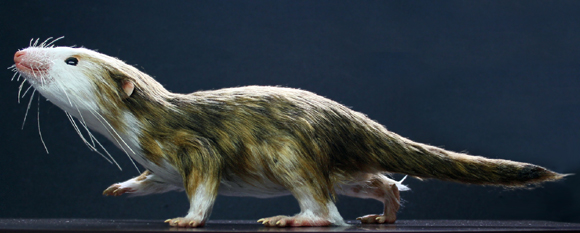Nibbling Away at Earliest Date for True Mammals
An analysis of the teeth of a small shrew-like animal known as Brasilodon quadrangularis from Upper Triassic strata in the Paraná Basin of Brazil indicates that its fossils might represent the lineage towards true mammals. As such, it pushes back the origins of Mammaliaformes by 20 million years.
Analysis of three lower jaws from B. quadrangularis, each jaw representing a different growth stage demonstrates diphyodont dentition, a key characteristic of mammals.

Diphyodonty a Trait of Mammals and Their Near Relatives
Brasilodon is the oldest extinct vertebrate with two successive sets of teeth which includes only one set of replacements (diphyodonty). The first set starts developing during the embryonic stage and a second and last set of teeth develops once the animal is born. The dental replacement pattern occurs with the same temporal and morphological pattern that is a key feature of mammals. This differs from that of reptiles who regenerate new teeth multiple times during their lives, (polyphyodonty).
Researchers from the London Natural History Museum and King’s College London contributed to this international research programme which was led by scientists from the Federal University of Rio Grande do Sul.
Corresponding author of the paper, published in the “Journal of Anatomy”, Dr Martha Richter (Earth Sciences Department, Natural History Museum), commented:
“Comparative studies with recent mammal dentitions and tooth replacement modes suggest that this [B. quadrangularis] was a placental, relatively short-lived animal. Dated at 225.42 million years old, this is the oldest known mammal in the fossil record contributing to our understanding of the ecological landscape of this period and the evolution of modern mammals.”
20 Million Years Older than Morganucodon
The genus Morganucodon had been thought to represent the earliest mammaliaform, its fossils having been found in Europe (Wales), China and North America. Morganucodon fossil material is associated with the very latest Norian and the Rhaetian faunal stages of the Late Triassic. However, the genus Brasilodon is associated with much older Triassic deposition which took place around 225 million years ago.
Mammalian Characteristics
Diphyodonty is a complex and unique phenomenon that along with tooth replacement involves profound, time-controlled changes to the skull anatomy, for instance the closure of the secondary palate (the roof of the mouth) that permits the young to suckle, while breathing at the same time. It has also been shown to be linked to endothermy and even placentation (live birth) and that other significant mammalian trait, the growth of hair and fur.
Brasilodon comes from the Caturrita Formation which preserves a rich assemblage of fossil vertebrates including sphenodonts, lepidosaurs, rhynchosaurs, dicynodonts and numerous cynodonts as well as silesaurids and dinosaurs (theropods and sauropodomorphs). Fossils also found in this formation hint at an ancestor of the Pterosauria (Faxinalipterus).
Brasilodon probably lived in burrows like many rodents today.
Everything Dinosaur acknowledges the assistance of a press release from the Natural History Museum (London) in the compilation of this article.
The scientific paper: “Diphyodont tooth replacement of Brasilodon—A Late Triassic eucynodont that challenges the time of origin of mammals” by Sergio F. Cabreira, Cesar L. Schultz, Lúcio R. da Silva, Luiz Henrique Puricelli Lora, Cristiane Pakulski, Rodrigo C. B. do Rêgo, Marina B. Soares, Moya Meredith Smith and Martha Richter published in the Journal of Anatomy.


